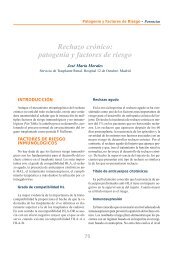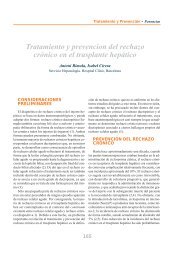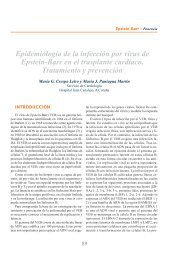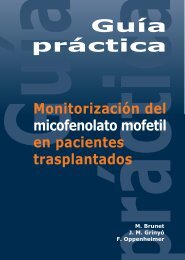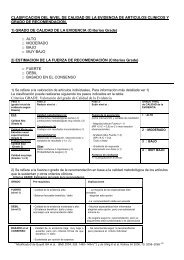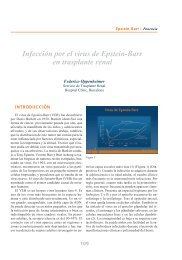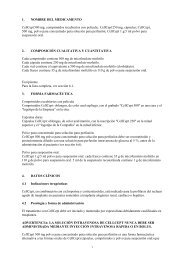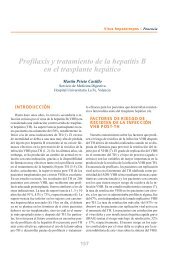Untitled - Roche Trasplantes
Untitled - Roche Trasplantes
Untitled - Roche Trasplantes
You also want an ePaper? Increase the reach of your titles
YUMPU automatically turns print PDFs into web optimized ePapers that Google loves.
EARLY DIAGNOSIS OF CHRONIC ALLOGRAFT NEPHROPATHY<br />
BY MEANS OF PROTOCOL BIOPSIES<br />
long term cyclosporine dosage with a cut off point at a maintenance dose of about 5 mg/<br />
kg/day. The histological appearance that is classically described is of a nodular hyaline<br />
change in the wall of renal arterioles (14). In our data, however, this classical change often<br />
gave way to more diffuse change with narrowing of the lumen and evidence of glomerular<br />
ischaemia. The question thus arises as to whether the arteriolar change may be<br />
associated with hypertension or with diabetes in our series. We were able to dispel these<br />
two possibilities since treated hypertension succeeded the appearance of arteriolar hyalinosis<br />
and did not preceed it as would be expected if it had a role in aetiology, also 60%<br />
of hypertensive and 68% of normotensive patients had arteriolar changes. With respect<br />
to the possibility of an effect from diabetes, the simultaneous glucose tolerance test performed<br />
with each protocol biopsy showed identical glucose handling in those with and<br />
those without arteriolar changes (38).<br />
Glomerular disease<br />
The final pathway for damage to the nephron is exhibited through glomerulosclerosis,<br />
with which irreversible loss of glomerular and nephron function occurs. Glomerular filtration<br />
rate is also closely linked to the glomerular sclerosis, especially as the number of<br />
functioning nephrons falls and glomerular hyperfiltration capacity is exceeded. There are<br />
at least three different mechanisms of destruction and pathologies that can be discerned<br />
in transplant glomeruli.<br />
Recurrent glomerulonephritis<br />
Occurs at different frequencies in different diseases and may account for a significant<br />
number of graft failures, such as in focal and segmental glomerular sclerosis (FSGS), or<br />
be essentially irrelevant such as in systemic lupus erythematosus (SLE) (15). No more<br />
will be said here about recurrent disease except to note that an increase in proteinuria<br />
by >500 mg/day or an absolute excretion rate of >1,500 mg/day are a reliable guide to the<br />
need for a diagnosis of the glomerular pathology (39), except possibly in patients treated<br />
with sirolimus or everolimus.<br />
Chronic transplant glomerulopathy<br />
In which the earliest signs, seen on electron microscopy include splitting of the basement<br />
membrane. This may be associated with the deposition of C4d and chronic antibody<br />
mediated damage to the glomerulus (40). It has been well accepted since the 1960’s<br />
that antibody to HLA mediates hyperacute and forms of acute rejection. Transplant glomerulopathy<br />
was recognised as early as 1963 with enlarged glomeruli, mesangial matrix<br />
expansion, changes in mesangial cells and splitting of both the glomerular and peritubular<br />
basement membranes (41). Perhaps lulled into a false sense of security by the improvement<br />
in crossmatching techniques, or perhaps by the confounding factors sur-<br />
21




